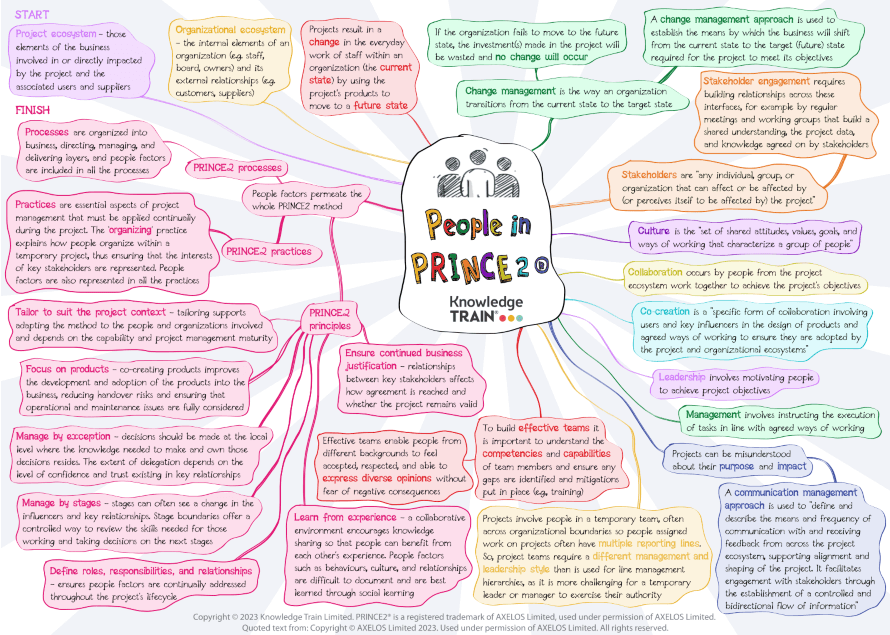
Introduction
This guide to People in PRINCE2 is one in a series of four study guides designed to prepare students for attending a PRINCE2 Foundation course. The other three – PRINCE2 principles, PRINCE2 processes, and PRINCE2 practices – are available to download as ebooks.
These articles have all been updated to they are based upon the 7th edition of PRINCE2 which was released in 2023. We recommend you read all four articles.
In PRINCE2, people are central to everything that happens in the PRINCE2 processes, its practices, and principles.
Read on to learn all about People in PRINCE2 and start preparing yourself for the PRINCE2 Foundation exam.
Project and organizational ecosystems

Projects deliver products, which are used by, and affect people within, their business-as-usual activities. These outcomes change the way these people do their work.
How well the change is implemented depends on the project team’s capabilities, their relationships, and the people impacted by the change. For successful project delivery leadership levels must establish a project culture that motivates people.
Decisions should be made close to where relevant knowledge resides. Decisions should be escalated only if there is a need to consider the impact on other areas. These areas are the project ecosystem (elements of the business involved in or directly impacted by the project and the associated users and suppliers) and the organizational ecosystem (internal elements of an organization e.g. staff, board, owners, and its external relationships e.g. customers, suppliers).
Change management
Projects result in a change in the everyday work of staff within an organization (the current state) by using the project’s products to move to a future state. Effective leadership is required to deliver this change.
Change management is the way an organization transitions from the current state to the target state. If the organization fails to move to the future state, the investment(s) made in the project will be wasted and no change will occur. A change management approach is used to establish how the business will shift from the current state to the target (future) state required for the project to meet its objectives.
Stakeholders
Stakeholders are “any individual, group, or organization that can affect or be affected by (or perceives itself to be affected by) the project” [1]. A project must engage its stakeholders to be successful.
To lead successful change requires an understanding of the relationships between the project and organizational ecosystems, and the ability to identify key stakeholders at the interface between them.
Stakeholder engagement requires building relationships across these interfaces. This can be done with regular meetings and working groups that build a shared understanding, the project data, and knowledge agreed on by stakeholders.
Culture is the “set of shared attitudes, values, goals, and ways of working that characterize a group of people” [2]. There may be different cultures within the same organization. A project team may need to establish a project culture different from the business whilst still aligned with the organizational ecosystem.
Collaboration, co-creation, and leadership
Collaboration occurs by people from the project ecosystem work together to achieve the project’s objectives. Co-creation is a “specific form of collaboration involving users and key influencers in the design of products and agreed ways of working to ensure they are adopted by the project and organizational ecosystems” [3].
Leadership involves motivating people to achieve project objectives. This entails collaboration across the project ecosystem, persuading, influencing, and co-creating, managing relationships, and seeking regular feedback to ensure team members stay aligned to the project’s objectives and agree to joint ways of working.
Management
Management involves instructing the execution of tasks in line with agreed ways of working. Co-creating ways of working with project team members (and stakeholders) improves people’s willingness to be managed.
Projects can be misunderstood about their purpose and impact. A communication management approach is used to “define and describe the means and frequency of communication with and receiving feedback from across the project ecosystem, supporting alignment and shaping of the project. It facilitates engagement with stakeholders through the establishment of a controlled and bidirectional flow of information” [4].
Projects involve people in a temporary team, often across organizational boundaries so people assigned work on projects often have multiple reporting lines. So, project teams require a different management and leadership style than is used for line management hierarchies, as it is more challenging for a temporary leader or manager to exercise their authority.
Effective teams
To build effective teams it is important to understand the competencies and capabilities of team members and ensure any gaps are identified and mitigations put in place (e.g., training). As temporary organizations, project teams may not have worked together before and may need to discover how to work effectively together. Roles and responsibilities should reflect the capability, authority, and availability of the individual doing the work.
An effective team can contain a diversity of members who must feel accepted, respected, and able to express diverse opinions without fear of negative consequences. All members are responsible for creating this psychological safety for each other through their day-to-day interactions and by caring for each other’s wellbeing. Members also need space to experiment, inspect, adapt, self-organize, and adjust ways of working.
PRINCE2 supports building effective teams through the:
- Project plan – explains the team’s goals and helps create a sense of purpose.
- Project management team structure and role descriptions – explains the team structure, roles, responsibilities, and relationships, and identify any coaching or training needs.
- Communication management approach – explains how team members will actively engage with and support each other, and how relationships will be developed between different groups.
- Project initiation documentation – explains agreed ways of working, empowering the team to focus on project delivery.
- Product based planning – emphasises gaining agreement about what will meet user needs and clarifying the dependencies and sequencing of key products.
Whether projects are delivered virtually, in person, or through a hybrid approach, the ways of working together must be agreed to optimize people’s time and build social cohesion. Social cohesion is developed by:
- people meeting in a purposeful way on a regular basis and building trust.
- considering how key relationships will be developed and maintained during the project.
- considering the benefits of co-locating a team to facilitate organic relationship building.
Virtual or hybrid teams may need additional activities to build social cohesion such as:
- syncing co-location days for key people and teams.
- allowing time for less structured online conversations.
- holding ‘away days’.
- using virtual collaboration tools to increase effectiveness and efficiency.
- providing opportunities or incentives for people to meet and socialize face-to-face.
The three people-focused activities: leading successful change, leading successful teams, and communication means that people are central to PRINCE2.
People factors
People factors are evident in the PRINCE2 principles, practices, and processes.
Principles
People factors permeate the 7 PRINCE2 principles.
Ensure continued business justification
Relationships between key stakeholders affects how agreement is reached and whether the project remains valid.
Learn from experience
A collaborative environment encourages knowledge sharing so that people can benefit from each other’s experience. People factors such as behaviours, culture, and relationships are difficult to document and are best learned through social learning.
Define roles, responsibilities, and relationships
Ensures people factors are continually addressed throughout the project’s lifecycle.
Manage by stages
Stages can often see a change in the influencers and key relationships. Stage boundaries offer a controlled way to review the skills needed for those working and taking decisions on the next stages.
Manage by exception
Decisions should be made at the local level where the knowledge needed to make and own those decisions resides. The extent of delegation depends on the level of confidence and trust existing in key relationships. Improving confidence and trust improves the ability to manage by exception.
Focus on products
Co-creating products improves the development and adoption of the products into the business, reducing handover risks and ensuring that operational and maintenance issues are fully considered.
Tailor to suit the project context
Tailoring supports adapting the method to the people and organizations involved and depends on the capability and project management maturity, which evolves over time as people gain a better understanding of PRINCE2.
Practices
The 7 PRINCE2 practices are essential aspects of project management that must be applied continually during the project. The ‘organizing’ practice explains how people organize within a temporary project, thus ensuring that the interests of key stakeholders are represented. People factors are also represented in all the practices.
Processes
The 7 PRINCE2 processes are organized into business, directing, managing, and delivering layers, and people factors are included in all the processes.
References
[1] PeopleCert (2023). Managing Successful Projects Using PRINCE2. 7th Edition. PeopleCert. ISBN: 978-9925-34-450-5.
[2] PeopleCert (2023).
[3] PeopleCert (2023).
[4] PeopleCert (2023).
